The NVIDIA GeForce GTX 780 Ti Review
by Ryan Smith on November 7, 2013 9:01 AM ESTPower, Temperature, & Noise
As always, last but not least is our look at power, temperature, and noise. Next to price and performance of course, these are some of the most important aspects of a GPU, due in large part to the impact of noise. All things considered, a loud card is undesirable unless there’s a sufficiently good reason – or sufficiently good performance – to ignore the noise.
| GeForce GTX 780 Series Voltages | ||||
| GTX 780 Ti Boost Voltage | GTX 780 Boost Voltage | GTX 780 Ti Base Voltage | ||
| 1.187v | 1.1625v | 1.012v | ||
Taking a quick look at voltages, we find that our GTX 780 Ti operates at a slightly higher voltage at its maximum boost bin than the original GTX 780 did. The difference is minor, but the additional voltage may be necessary to hit the slightly higher clockspeeds GTX 780 Ti operates at relative to GTX Titan and GTX 780.
| GeForce GTX 780 Ti Average Clockspeeds | |||
| Max Boost Clock | 1020MHz | ||
| Metro: LL |
1000MHz
|
||
| CoH2 |
997MHz
|
||
| Bioshock |
954MHz
|
||
| Battlefield 3 |
980MHz
|
||
| Crysis 3 |
980MHz
|
||
| Crysis: Warhead |
1000MHz
|
||
| TW: Rome 2 |
950MHz
|
||
| Hitman |
993MHz
|
||
| GRID 2 |
967MHz
|
||
| Furmark |
823MHz
|
||
Moving on to clockspeeds, we find that the GTX 780 Ti does very well when it comes to boosting. With a maximum boost clock of 1020MHz, we have 2 benchmarks averaging 1000MHz, and another 4 averaging 980MHz or better.
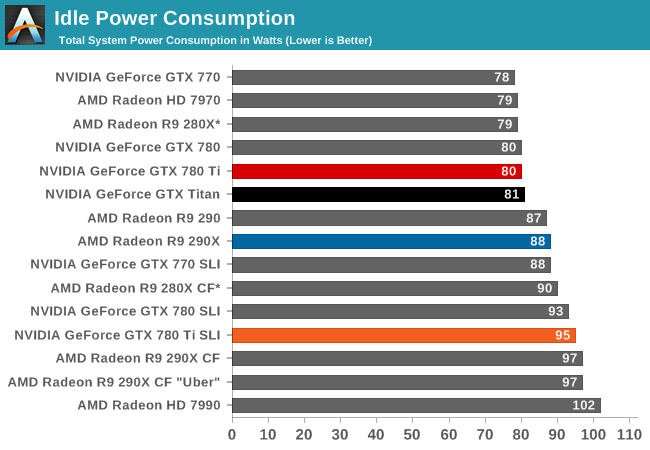
With all of our GK110 cards sharing a common design, at idle there’s very little to differentiate them. Other than GTX Titan’s extra 3GB of VRAM, we’re essentially looking at identical cards when idling.
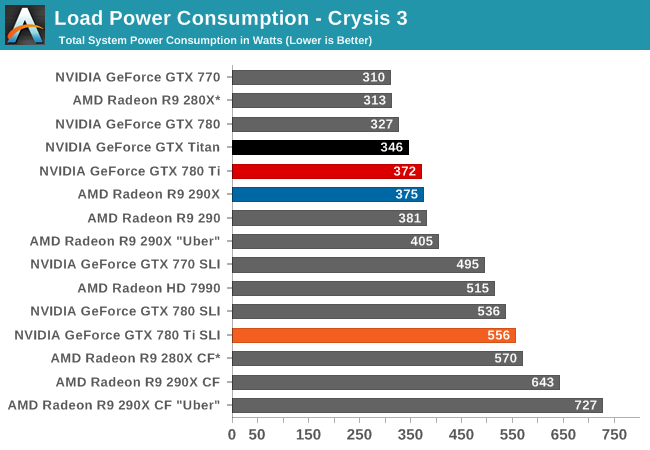
Moving on to load power, we can see the power/heat ramifications of the slight clockspeed increase coupled with the activation of the 15th SMX. Even with the further optimizations NVIDIA has put into the new revision of GK110, power consumption has gone up in accordance with the higher performance of the card, just as we’d expect. Since NVIDIA doesn’t notably alter their power efficiency here, that increased performance has to come at the cost of increased power consumption. Though in this benchmark it’s worth pointing out that we’re measuring from the wall and that GTX 780 Ti outperforms GTX Titan by 8%, so some of that 29W power difference will come from the higher CPU load caused by the increased framerates.
As for the GTX 780 Ti SLI, here we see power level off at 556W, 20W more than the GTX 780 SLI. Some (if not most) of that is going to be explained by the increased CPU power consumption from the GTX 780 Ti SLI’s higher framerates. Coupled with that is the fact that in SLI setups these cards get hotter, and hence have to downclock a bit more to maintain equilibrium, which helps to offset the increased power requirements of GTX 780 Ti and keep the SLI results so close to the GTX 780 SLI results.
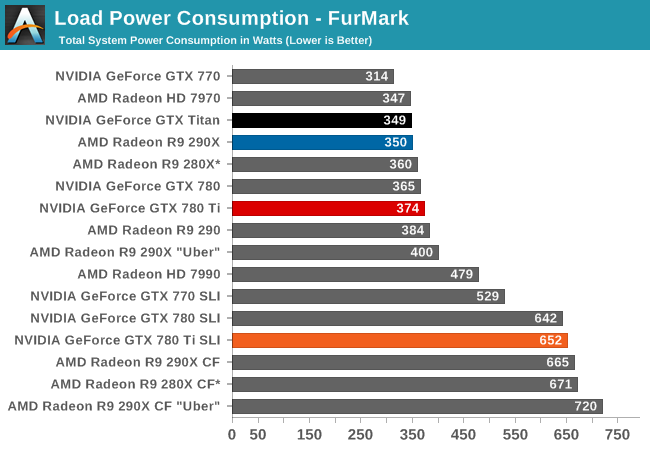
Switching over to FurMark, we find that power consumption is also up, but only slightly. With GPU Boost 2.0 clamping down on power consumption all of our GK110 cards should be clamped at 250W here, and with a difference between GTX 780 and GTX 780 Ti of under 10W, that’s exactly what appears to be happening here.
On a side note, it’s interesting to note here that under FurMark we’re seeing the GTX 780 Ti draw more power than the Radeon R9 290X. Despite the fact that the 290X has a higher rated TDP, in the card’s default quiet mode the card can’t actually dissipate as much heat (and thereby consume as much power) as the GTX 780 Ti can.
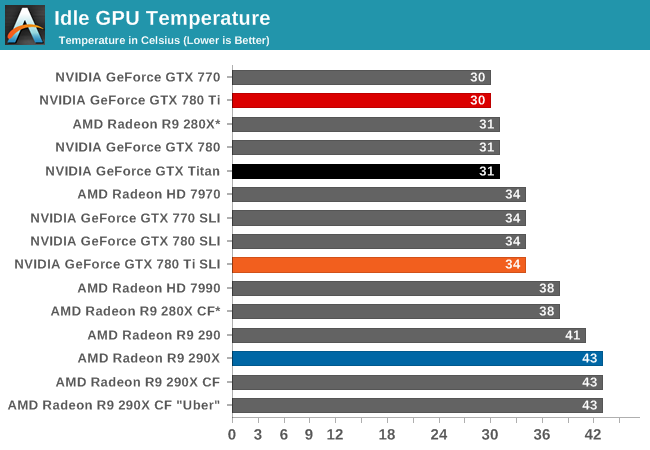
For idle temperatures we’re once again looking at cards that are for all intents and purposes identical. At 30C the GTX 780 Ti easily stays nice and cool.
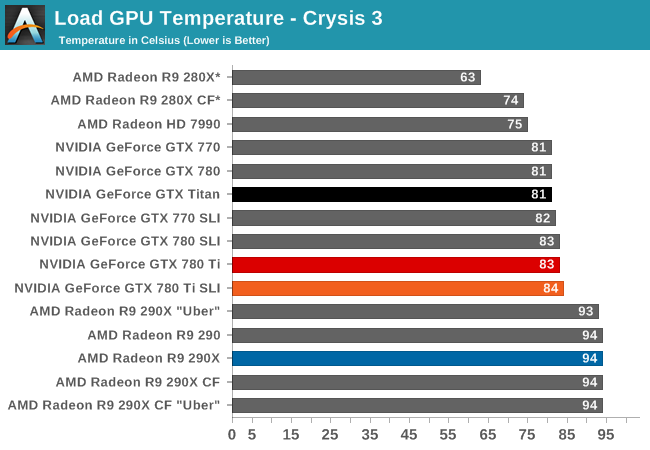
As we mentioned in our look at the GTX 780 Ti hardware, NVIDIA has increased their default temperature throttle point from 80C on the GTX Titan/780 to 83C on the GTX 780 Ti. The end result is that in all of our temperature limited tests the GTX 780 Ti will peak at 83C-84C, whereas the older GK110 cards will peak at 80C-81C.

FurMark reiterates what we saw with Crysis 3. The temps are up a bit across the board, while the GK110 cards are holding near their throttle points. The SLI setups meanwhile approach the upper-80s at 88C, reflecting the fact that even with blowers, there’s some impact on neighboring cards in high load situations.
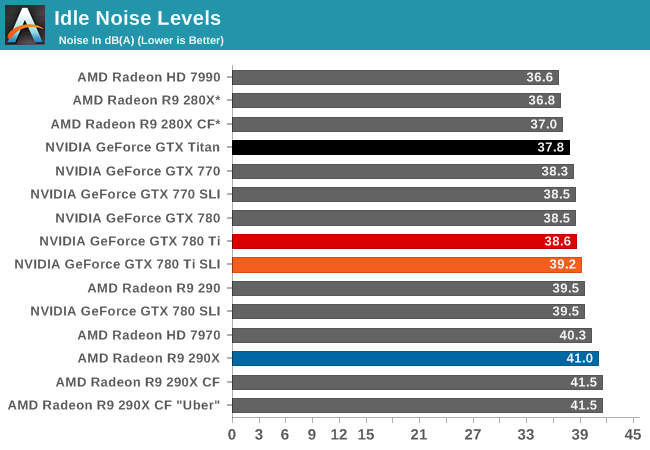
Our last idle scenario, we once again see all of our GK110 cards performing similarly, with idle noise levels in the 38dB-39dB range.
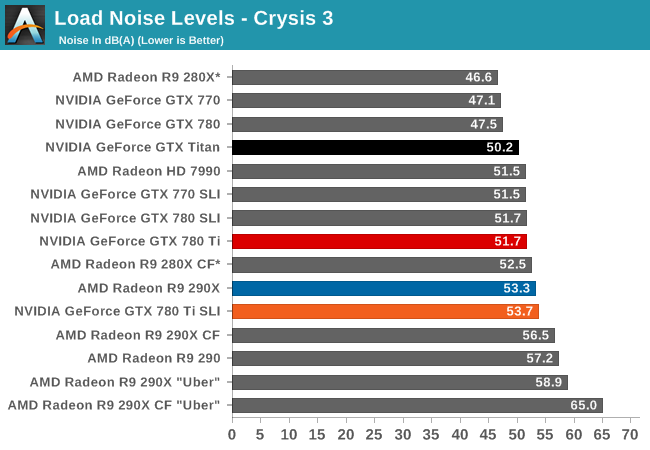
Moving on to our gaming load noise results, we can see the full repercussions of the GTX 780 Ti’s higher average power consumption coupled with the card’s higher temperature throttle point. Moving the throttle point along the same curve has the end result of moving higher the equilibrium point and thereby the card’s operating noise levels. As the fastest single-GPU card on this card, the GTX 780 Ti is still doing very well for itself and for a blower based design at 51.7dB, though at 1.5dB louder than GTX Titan and 4.2dB louder than GTX 780 the noise tradeoff for the card’s higher performance is very clear. Meanwhile the fact that it’s tied with the GTX 780 SLI comes with its own bit of irony.
Speaking of the GTX 780 SLI, we can see the noise impact of SLI configurations too. The GTX 780 Ti SLI levels out at 53.7dB, 2dB louder than our single-card configuration and 2dB louder than the GTX 780 SLI. At this point it’s just a bit louder than the 290X and quieter than a number of other 290 series setups.
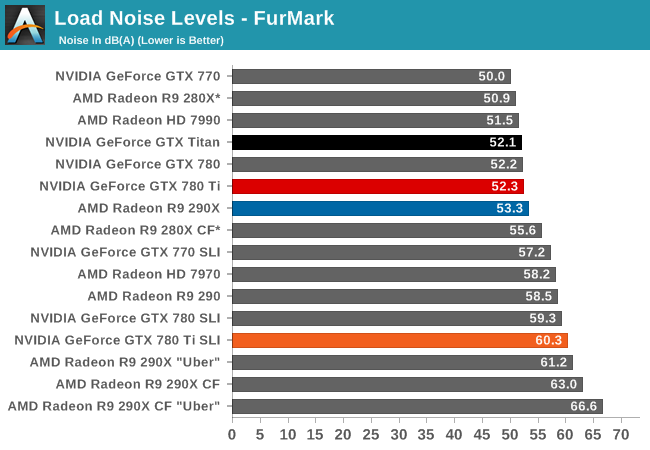
Finally with load noise levels under FurMark we can see where our various cards will peak at for noise levels. The GTX 780 Ti creeps up to 52.3dB, essentially tying with the GTX 780 and GTX Titan. Otherwise it comes in just behind the 290X, and the start of the pack for our multi-GPU setups.
As for the GTX 780 Ti SLI, like our single-card comparison points its up slightly as compared to the GTX 780 SLI.
Overall, our look at power, temperatures, and noise has been a rather straightforward validation of our earlier suspicions. GTX 780 Ti’s higher performance leads to higher power consumption, and will all other factors being held equal – including the cooler – power, temps, and noise levels all rise a bit as compared to GTX Titan and GTX 780. There’s no such thing as a free lunch here, and while GPU Boost 2.0 will keep the maximum levels suitably in check, on average GTX 780 Ti is going to be a bit worse than the other GK110 cards due to those factors. Though even with the increased noise levels in particular, GTX 780 Ti is still able to outperform 290X on noise while also delivering better gaming performance, which makes this another tidy victory for NVIDIA.










302 Comments
View All Comments
beck2448 - Tuesday, November 12, 2013 - link
They live in a dream world. Pros buy Nvidia 80% plus. That says everything about quality and reliability.Mondozai - Friday, December 13, 2013 - link
EJS, the buttboy for Nvidia, most sane people are non-fanboys.This means most people, including myself, skipped AMD the last few generations because they did a shitty job. We bought Nvidia hardware instead. Now, the roles will be changed with aftermarket coolers.
Also, please don't talk about mouthbreathers when you're literally chewing cowshit in your mouth everytime you're trying to say something. It stinks.
xdesire - Saturday, November 9, 2013 - link
You really don't know what you are talking about. Obviously, R9 290 holds great price/performance value but GTX 780 Ti has great OC potential out of the box. I'm afraid AMD shot themselves on their own foot with this reference coolerGrugtuck - Friday, November 8, 2013 - link
Any reason why the 900000000 pound gorilla in the room isnt mentioned here? 290x spanks the living **** out of the 780i in CF vs SLI. It makes me think that driver issues are still not fully sorted out.Ryan you sound like an absolute idiot when you say that no one is going to need SLI or CF any more. I also think its interesting how these days suddenly 60FPS is the standard to live by when it comes to FPS. I started playing PC games competitively back around 2002 and 80FPS has always been what people shot for, not 60. 60 is the bar min for acceptable smooth play, its not the optimal for competitive or serious FPShooter gaming.
lostsanityreturned - Saturday, November 9, 2013 - link
Hmmm I figured I would run a quick bench... my OCed 780 gigabyte with stock cooling gets the same average fps as their OCed 780ti in metro... 67fps 1440p high preset.I imagine it would be even higher if I uninstall comodo (which seems to drop my average fps by 5-14 frames just by being installed even if everything is disabled and profiles are set up correctly to ignore games, goes right back up if uninstalled though)
I hit 77degrees after my third run and it dropped back down to 75 soon after when the fans ramped up again, keeping in mind this is Western Australia I am in currently at 34 degrees (that is 94.2 Fahrenheit), all the windows open and no air-conditioning with an aircooled case.
It isn't even a demanding overclock +161 to core and +189 to memory... which considering I usually run it at +181 and +201 with ease and stability (I turned it down to see what the results were for an easy overclock as they didn't push their 780ti much)
I was feeling like crap about them releasing a new card just 4=5months after I got the 780... now... not so
sf101 - Saturday, November 9, 2013 - link
I think obviously people are just irate with Nvidia thinking they can charge premiums on everything and not just small premiums but they seem really set on this +750$ area pricing refusing to cut their customer base a break on the overpricing.So they drop down the 780 GTX to 500$ and everyone cheers "ignorantly" !!! Really its just a smoke screen because they knew the 290 and 290x were out performing their card while running on poor performing cooling units and yet it still has a $100 premium over the 290 which also out runs it pretty much everywhere.
Now down come's the 780TI pooping all over early adopters of the 780 and more so the titan buyers who thought they were getting a flagship card and foolishly paid $1000+ for them.
But its not all bad because heck man performance is performance and the 780ti is obviously needed to keep Nvidia in this race so we all look past its release but can't look past its premium pricing which is just another rip off of the customers @ 150$ over the competitor's pricing which closely competes at lower resolutions and fails to out perform @ 4k and in SLI/crossfire configurations.
Now all that would be just business as usual if Reviewer's were Educating about AMD's crossfire and high resolution performance wins over even the new and improved 780TI.
Instead they are quiet as a mouse to All AMD's Wins aside from pricing because well that's obvious and hard to ignore right. and rip AMD a new one over the downsides aka heat and noise which is totally justified and expected.
While for the nvidia side of things its all Christmas and Win's on the review reading in such a way that the 780ti wins in every category. failing to mention the Wattage use is getting up there as well as heat and fan noise, perhaps not up to 290x height's but much further than the GTX780.
All of these things have been pointed out on other review sites the good and the bad.
FuriousPop - Sunday, November 10, 2013 - link
lol, at the end of the day its all about target marketing.... excluding the fanboys of course. Fanboys = omg its better, faster, cooler oh oh i gotta have it. where as most normal people will analyse the cost of the GPU in relation to its performance to which if applicable to them would do other little upgrades to it/their case if need be, if it all still fits into the equation of how much to spend. etc etcdo your research, read lots of reviews, ask questions(if any) then purchase and don't look back. pretty simple.....
most of you all come here to rage and fire shots to either side (great entertainment btw) reminds me of that Halo Red Vs Blue. more like "fanboys - Red Vs Green" oh hey hey - why Red first eh eh!?
SymphonyX7 - Saturday, November 9, 2013 - link
Why exactly would I buy a GTX 780 Ti, when for a $100 more I can get TWO Radeon R9 290s in SLI and get twice the performance? The heat issue is there, but it ain't nothing an aftermarket cooler can't handle like the Accelero Xtreme 3.AMD wouldn't have flinched from the GTX 780 Ti's launch had it not been for their utterly terrible reference coolers.
SymphonyX7 - Saturday, November 9, 2013 - link
I meant Crossfire, not SLI. But you get the point. Have you seen those CF 290x vs SLI 780 Ti numbers? That's a ridiculous beatdown.TheinsanegamerN - Saturday, November 9, 2013 - link
you know, what i see from this, is that the 290x in uber mode is just as fast as the 780ti in most senarios, and is often a little faster. which should mean that the third party coolers that get slapped on these things should allow the 290x to soundly beat the 780ti. lets get the windforce 3x version of both these cards when they come out, and bench those for a more equal review.